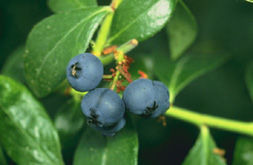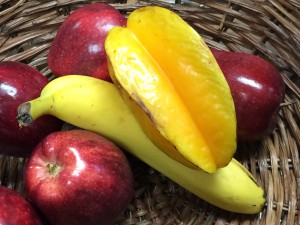
Crops in Season – Blueberries
 July is National Blueberry Month and what a great testament it is to be named fruit of the month during this patriotic season! Blueberries are one of the few fruits native to North America and have been enjoyed for centuries, both wild and cultivated. In fact, the United States is the world’s largest producer of blueberries. Although Florida has hundreds of small blueberry farms across the state, Michigan still leads the pack in national blueberry production.
July is National Blueberry Month and what a great testament it is to be named fruit of the month during this patriotic season! Blueberries are one of the few fruits native to North America and have been enjoyed for centuries, both wild and cultivated. In fact, the United States is the world’s largest producer of blueberries. Although Florida has hundreds of small blueberry farms across the state, Michigan still leads the pack in national blueberry production.
Nonetheless, blueberries are an important agricultural crop as well as a nutritional powerhouse. Blueberries are the fruits of a shrub, they grow in clusters, and range in size from that of a small pea to a marble. Blueberries are deep in color, ranging from blue to purple-black, and feature a white-gray waxy “bloom” that covers the berry’s surface and serves as a protective coat. The skin surrounds a semi-transparent flesh that covers tiny seeds.
Blueberries are low in calories (84 per cup), high in fiber (4 grams per cup), and full of antioxidants, vitamins, and minerals. Additionally, blueberries taste delicious, producing flavors that range from mildly sweet (cultivated) to tart and tangy (wild).
When purchasing (or picking), choose blueberries that are firm and have a uniform color. Avoid berries that appear dull in color or are soft and watery in texture.
Before refrigerating blueberries, remove any damaged or moldy berries to prevent the rest from spoiling. Don’t wash berries until right before eating, as washing introduces moisture, which speeds up the decaying process.
If you plan to freeze your blueberries, don’t wash before freezing, as washing can make their skins tough. Instead, simply pack your blueberries into a freezable container, seal, and freeze.
An alternative way to freeze blueberries that may make the fruit easier to remove from the container is to simply spread a single layer of prepared berries on shallow trays and freeze (lining the pan with a piece of parchment paper works well here, too). When frozen, strike the tray on a counter, then promptly and properly package, label, and return the blueberries to the freezer. The fruit pieces will not stick together, and small quantities of blueberries can be removed easily for use, but be sure to wash the thawed berries prior to use.
Most frozen fruits maintain high quality for eight to twelve months at 0°F or below. Unsweetened fruits lose quality faster than those packed in sugar or syrup. Longer storage will not make the food unfit for use, but may impair its quality. As with all frozen foods, it is a good idea to use the FIFO method (First In, First Out) when taking out of the freezer.
Blueberries are not just for pie anymore. Branch out a bit. The Florida Blueberry Growers Association has a database of recipes for drinks, breakfast foods, breads, appetizers, salads, dressings, sauces, entrée items, and desserts.
Just like summer… blueberries are full of endless possibilities. Try some today!
Check out these other Fresh from Florida items in season in July: http://www.freshfromflorida.com/content/download/16798/269945/07July.pdf
BLUEBERRY SALSA
Ingredients:
- 2 cups fresh blueberries
- 1 cup finely diced fresh Florida mango
- 1 cup finely diced fresh Florida cantaloupe
- 1 cup finely diced fresh Florida watermelon
- 1 jalapeno pepper, seeds and membrane removed, minced
- 2 to 3 tablespoons lime or lemon juice, divided
- 1/2 teaspoon lime zest
- 3 tablespoons chopped cilantro
- 1 garlic clove minced
- 1/4 cup diced red onion
- Salt as needed
Directions:
- Combine the fruit, jalapeño, 2 tablespoons of the lime juice, lemon or lime zest, cilantro and red onion.
- Season with salt and additional lemon or lime juice as needed.
- Serve with tortilla chips or as an accompaniment to fish or chicken.

